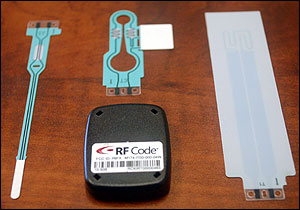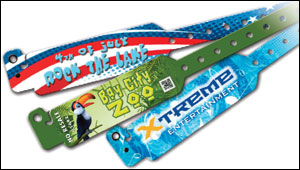Nov 28, 2013The following are news announcements made during the past week by the following organizations: RF Code; Metalcraft; HID Global; SensMaster; Versus Technologies; AIM.
RF Code Announces New Asset-Management Tamper-Detection Tabs
RF Code has announced a new type of mounting tab with added security for tracking critical rack-mounted assets in data centers. Developed to be utilized in concert with the recently released M174 tag (see RFID News Roundup: RF Code Launches Smallest Active Asset-Management Tag), the new tab can be used to trigger a notification when tags are removed, replaced or altered. The tamper tabs—offered in a flag, loop or thumbscrew mounting design—feature a carbon fiber filament embedded in the tab's adhesive. Once the tamper tab is connected to an M174 tag, RF Code explains, the filament completes a tamper-detection circuit that—if subsequently broken—will cause the tag to immediately begin broadcasting a tamper alert status. After the tamper tab is applied to an asset, the circuit will be broken if the tag is cut, if the tag adhesive is peeled away from the asset or the tab itself, or it the M174 tag is pulled off the tamper tab by force. It takes approximately 8 pounds of force to pull the tag off the tab once it has been attached to an asset, the company reports, so normal movements of assets will not break the circuit or trigger tamper alerts. The tag key is a thumb-size piece of plastic inserted into tab slots on the M174 asset tag, to permit the connection and disconnection of mounting tabs (both tamper detecting and non-tamper detecting adhesive backed tabs are available). To connect or disconnect a tab, a user inserts the key into two small slots on the M174 tag and then depresses it. Once this is done, tamper and standard mounting tabs can then be easily connected or disconnected from the M174 tag. The M174 is RF Code's smallest RFID-enabled asset-tracking tag to date. The battery-powered 433 MHz tag offers improved data transmission for higher accuracy, and a selection of installation tabs for flexibility in mounting and reuse throughout its lifespan. The M174 is designed to work with RF Code's A740 Rack Locator and A750 Room Locator, each of which transmits an infrared pulse pattern containing a unique three-digit location code. The M174 integrates four infrared (IR) sensors to ensure clear signal reception from a locator, regardless of direction. The tag broadcasts its unique ID number and received location code using RF Code's patented communication protocol, with anti-collision technology for environments containing a high tag density. The M174 tag was engineered for reuse throughout its lifetime. Tamper tabs can be removed and replaced from the tag as needed, via the use of a tag key.
Metalcraft Unveils RFID Wristbands for Waterparks, Amphitheaters, Outdoor Events
Metalcraft has announced the availability of RFID wristbands designed for efficient access control at waterparks and outdoor events. The company's RFID wristbands feature full-color printing and a durable construction, and consist of specialized RFID inlays encapsulated in 0.009-inch-thick polypropylene material—which, the company reports, enables the wristbands to withstand all-day submersion in water, as well as exposure to suntan lotion and insect repellent. The wristbands are available in an ultrahigh frequency (UHF) 860 to 960 MHz version, with an Alien Technology Squiggle-SH inlay, a high-frequency (HF) 13.56 MHz version with either a Texas Instruments Mini Tag-it inlay or an inlay made with NXP Semiconductors' Mifare Ultralight chip. The label copy on the wristband can include block type, stylized type, logos or other designs, and the wristbands come in a standard size of 15.75 inches by 1.5 inches, in black, red, yellow, green and blue; the construction features a secure snap to prevent easy removal. Due to contrast required for the bar-code scanner, all bar codes are black, the company explains. Both the bar code and human-readable text are produced using high-resolution digital technology, and can be programmed into the RFID inlay as long as the information is in decimal or hexadecimal format. The programmed information can be locked, which prevents the RFID inlay from being rewritten. Metalcraft can encode up to 24 characters into the RFID inlay. If requested, the firm says it can encode information that differs from the bar-coded and human-readable data.
HID Global Adds RFID to Fargo Direct-to-Card Printer Line
HID Global, a provider of secure identity solutions, has announced an update to its Fargo Direct-to-Card (DTC) printer line, designed to allow small, medium and large private and government organizations to produce ID, access-control, payment and loyalty cards. The enhanced Fargo DTC printers now feature an embedded multi-technology iClass SE RFID encoder, which, according to HID Global, simplifies card technology migration and helps personalize large ID card batches, all from within the printer. The DTC portfolio also includes expanded inline personalization features that offer faster speeds and increased flexibility, the company reports, with an optional wireless accessory module that allows users to issue cards at any time, from anywhere. Specifically, Fargo DTC printers can be specified to include HID Global's iClass SE encoder, which enables all credential creation, encoding, personalization and management for large ID card batches to be performed inside the printer, in a single issuance step. According to HID Global, this reduces administrative burdens and hardware costs. Cards can be encoded with unique company or employee information, and programmed to work with a variety of physical access-control systems, anywhere in the world, depending on the permissions written onto the card. Users can streamline all card ordering, inventory management and issuance processes, while maintaining maximum flexibility, security and end-to-end operational control. The new printer line also feature faster print speeds, and can be used to produce 50 percent more cards in the same amount of time as the company's earlier DTC models, HID Global reports. What's more, the firm adds, the new models can deliver cards to users 50 percent more quickly than was previously possible. Cards can be produced from any location, at any time, when using HID Global's Asure ID card personalization software on a Microsoft Windows 8 Pro Tablet over a secure wireless network. An optional Wi-Fi accessory, connected to any Fargo DTC printer-encoder, eliminates the need for wall-mounted Ethernet jacks and cables, according to HID Global. The solution gives users a wide range of capabilities for secure, on-demand credential enrollment and printing in the field, including the flexibility to add bar codes, company logos and a wide variety of visually rich, full-color card personalization options. HID Global's latest Fargo DTC portfolio includes four printers; each printer features AES-256 data encryption support, can be specified with a built-in iClass SE encoder and can be used with HID Global's Wi-Fi accessory for mobile card enrollment and issuance. The portfolio includes the DTC1000Me monochrome printer, for creating black and white images for simple card personalization; the Fargo DTC1250e color printer; and the DTC4250e and DTC4500e professional-grade color printers, which offer increased security with optional locking card hoppers (DTC4500e) and printer password protection. In addition, HID Global notes, the DTC4250e and DTC4500e models include Ethernet connectivity and are field-upgradeable, simplifying equipment migration to higher levels of security through the use of holographic or fluorescent (UV) overlaminates and dual-sided printing, to include additional visual elements. The enhanced Fargo DTC printers are available now.
SensMaster Intros Active RFID Sensor Tag for Personnel Safety Applications
SensMaster, a manufacturer of sensor-based RFID and Internet of Things (IoT) technologies, has announced a new RFID- and sensor-enabled wristband tag. The Tristan wristband tag, part of SensMaster's family of active 2.4 GHz RFID tags and readers, is a watch-style sensor tag intended for people safety, personnel tracking and security. It is designed to be used at ranges of up to 60 meters (197 feet), regardless of tag orientation. The wristband tag has an IP 65 rating (meaning that testing has confirmed it to be dustproof and waterproof), and includes two standard sensors, a proximity removal sensor and a motion detector, used to detect if a person is moving or not moving, or if the wristband has been removed. The tag can be customized with such options as additional sensors (temperature sensors, for example), Near Field Communication (NFC), or support for ISO 18000-63 and EPC Gen 2 standards. The Tristan can communicate the tag's movement, location and sensor values, as well as the tag's unique identifier—such as an Electronic Product Code (EPC), the user's name or some other customer-defined ID—to SensMaster readers or access points installed on local area networks. The Tristan leverages SensMaster's anti-collision RFIDS technology, which the company says enables each reader to cull data from thousands of tags simultaneously. The wristband tag provides its own alert logic, which is shown by a device status flag (DSF). Via the DSF, the company explains, the tag's behavior can be controlled from sensor input according to a policy set by the user. For instance, if a policy is set that the tag should not be removed from the wearer, the proximity removal sensor can trigger the tag's DSF to Alert state, by which the tag will send an Alert message in a fast sequence at full radio output power, regardless of other settings, if the proximity removal sensor is triggered (typically, the ultra-low power radio will transmit at regular intervals). The Alert state can only be reset to Idle or Guard states via an access code-protected command from an authorized reader. According to SensMaster, other policies can be set in the application as well—for instance, determining that a person must be in a certain zone during a predefined time period, and issuing an alert if that person is leaving the zone, or that at least one individual authorized to manage a control room must always be present in that room. In the case of an emergency situation, the application can quickly present an inventory of all personnel within a facility, along with their locations. User interface options include displays, light indicators and push buttons. The Tristan is available in multiple colors. Initial samples are already shipping to SensMaster partners, and the company expects volume orders to ship out during the first quarter of 2014.
Washington Clinic Improves Patient Waiting Times, Workflow With Versus' RTLS
A new clinic in Monroe, Wash., opened by Providence Health & Services, a health-care provider in Washington State, is reducing patient wait times and improving workflow using a real-time location system (RTLS), according to Versus Technology, which provided the RTLS to the clinic. Versus' Advantages Clinic RTLS employs infrared (IR) signals, as well as RFID as a backup solution, in the event that the IR signal is blocked or not operating properly. When a tag's IR signal, emitted every three seconds, is received by the IR reader at a particular location, the interrogator transmits its own ID number, along with that of the tag, to the Versus software. In the event that the IR signal is not being received (if, for instance, a blanket is covering the tag and its infrared beacon), the RFID system provides a backup by emitting a 433 MHz RFID signal—which also beacons every three seconds—using a proprietary air-interface protocol. The tags and badges communicate via wireless, battery-powered V-Link sensors. With the RTLS in place, the Providence Monroe clinic can use the badges and tracking software to more easily locate patients, personnel and medical equipment; immediately direct patients to an available examination room, using an automatically updated color-coded floor plan of the clinic that is informed by the RTLS solution; track how long a patient remains in the exam room before being seen by caregivers; and alert staff members if a patient is alone for more than 10 minutes at any point during a visit. The RTLS can also display who has seen a particular patient, and who still needs to see patients, on an electronic white board. It can also automatically indicate when rooms are ready for turnover after patient discharge, as well as report on key performance metrics, such as arrival to nurse, arrival to provider, overall exam duration, overall length of stay and more. The Versus Advantages Clinic RTLS implementation at the Monroe clinic was carried out by AAtronics, a Versus certified systems integrator. Providence Monroe joins several clinics implementing RTLS technology for patient flow, including the Key-Whitman Eye Center (see Texas Ophthalmology Clinics to Address Wait Times With RTLS) and the Ann Karmanos Cancer Institute (see Karmanos Cancer Institute Seeks to Eliminate Bottlenecks Via RTLS).
AIM Creates AIM Europe to Guide Regional AIDC Growth
AIM, an international industry association focused on bar-code, RFID, real-time location system (RTLS) and mobile-computing technologies, has announced the formation of AIM Europe, which the association says has been created to secure a single entity representing AIM's member network of automatic identification and data capture (AIDC) experts across the region, establish a system for industry growth in new and emerging areas, have strategies in place to respond to new technology and market developments, and create the best access to funding for international and national development projects related to AIDC technology, innovations, standards, and applications. AIM will now consist of AIM Americas, AIM Europe, and chapters representing China and India. AIM Europe will allow for collaborative involvement in critical AIDC opportunities throughout the European region in a variety of areas, the association reports, including health care, tracking and tracing, maintenance, safety and security, cloud computing, the Internet of Things and smart networks. Frithjof Walk, a senior executive with German RFID hardware manufacturer Feig Electronic, has been elected president of AIM Europe. As the umbrella organization for the existing AIM chapters in Germany, Netherlands and Russia, Walk says, AIM Europe will coordinate efforts to provide a stronger, better connected and funded entity for continued growth and expansion.




